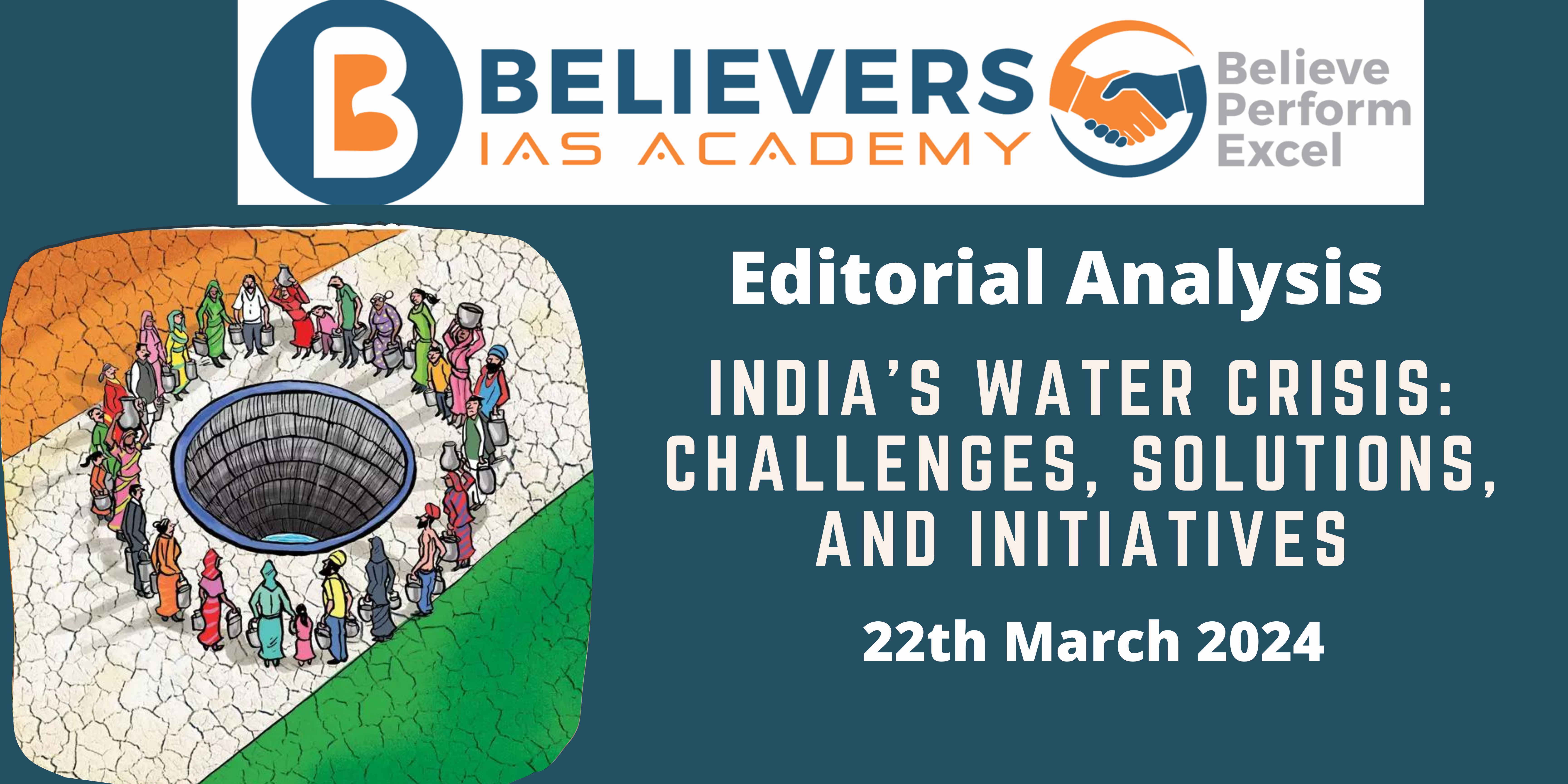India’s Water Crisis: Challenges, Solutions, and Initiatives
Context:
Every year it on March 22, it is observed as World Water Day. It aims to raise global awareness about the importance of freshwater resources. This year’s theme being “Water for Peace,” underscores the crucial role of water in maintaining peace and stability.
Relevance:
GS-03 (Conservation)
Key highlights:
- India faces significant challenges related to water scarcity, driven by factors like rapid urbanization, climate change, and unsustainable water management practices.
- Groundwater depletion, inadequate infrastructure, and pollution further exacerbate India’s water crisis.
- Rainwater harvesting emerges as a vital solution to enhance water availability and quality, with the government emphasizing initiatives like “per drop more crop” and “Har Medh per ped.”
Facts for Prelims:
- Narmada Bachao Andolan v Union of India (2000): A landmark case in India’s history of inter-state water disputes. The Court noted that the project would violate Article 21 of the Constitution of India and Convention 107 of the ILO.
Mains Question:
Discuss the challenges posed by India’s water crisis and evaluate the role of rainwater harvesting in addressing these challenges. (250 words)
Dimensions of the article:
- Water Crisis in India: Challenges and Implications
- Causes of Water scarcity in India
- How to overcome water scarcity
- India’s Water Resource Management Initiatives
Water Crisis in India: Challenges and Implications
- India has about 18 percent of the world’s population but only 4 percent of the world’s water resources (NITI Aayog Report, 2017), making it among the most water stressed in the world.
- With 1,100 cubic meters (m3) per person, the available water falls significantly beneath the globally accepted threshold for water stress, set at 1,700 m3 per person, and is perilously near the threshold for water scarcity, which is 1,000 m3 per person.
- The crisis stems from a myriad of factors- rapid urbanization, industrialization, and unsustainable agricultural practices.
- This crisis manifests in both physical and economic forms.
- It poses significant threats to the nation’s development and stability.
- Groundwater depletion pronounced in states like Punjab and Rajasthan, highlights the urgency of addressing water management practices nationwide.
- Moreover, the deteriorating quality of water due to pollution is not only affecting human health but also ecosystem integrity.
- With 72% of water withdrawals allocated for agricultural use, the need for sustainable water management practices becomes increasingly pressing.
Causes of Water Scarcity in India:
- Rapid urbanization and industrialization leading to increased pollution of water bodies.
- Inefficient agricultural practices including excessive groundwater extraction.
- Climate change causing irregular rainfall patterns and affecting river recharge.
- Poor water management practices.
- Lack of proper infrastructure for water storage and distribution.
How to overcome water scarcity:
- Rainwater harvesting and efficient irrigation: Rainwater harvesting not only enhances water availability but also promotes environmental sustainability, laying the foundation for long-term water security. Moreover, to augment groundwater recharge, irrigation techniques such as Drip irrigation method, building percolation tanks and developing watershed managements are crucial.
- Government initiatives: Like “per drop more crop” and “Gaon ka pani gaon mein” underscore the importance of integrating rainwater harvesting into national water conservation strategies.
- Sustainable agricultural practices: The promotion of sustainable agricultural practices and watershed management further complements these efforts.
- Infrastructure: By building more distribution networks and working on upgrading water treatment plants.
- Public Awareness: Educating people about water conservation and sanitation practices alongside integrating private players is crucial.
India’s Water Resource Management Initiatives:
- National Disaster Management Agency (NDMA): Utilizes water-related data and technologies for disaster alerts and management, leveraging platforms like NavIC for timely dissemination of alerts.
- Pradhan Mantri Krishi Sinchayee Yojana (PMKSY): Launched to enhance farm water access and promote efficient irrigation, focusing on water use efficiency and conservation through micro-irrigation.
- Mission Amrit Sarovar: A part of Azadi Ka Amrit Mahotsav, aiming to conserve and rejuvenate 75 water bodies in each district.
- Jal Shakti Abhiyan (JSA): Conducted in water-stressed districts for water conservation and management, with the “Catch the Rain” campaign promoting rainwater harvesting.
- Jal Jeevan Mission (JJM): Aiming to provide potable tap water to every rural household by 2024, focusing on water-scarce areas and including bulk water transfer and regional water supply schemes.
- “Sahi Fasal” Campaign: Encourages water-efficient crop choices and sustainable cultivation practices in water-stressed areas for economic viability.
- Atal Bhujal Yojana (ABY): Implemented in water-stressed areas of seven states, emphasizing community participation and demand-side interventions.
- National Commission on Integrated Water Resources Development (NCIWRD): Provides insights for planning and managing water resources through reports on projected water requirements.
Way Forward:
- Comprehensive measures encompassing water conservation, rainwater harvesting, and sustainable agriculture must be prioritized.
- The government’s emphasis on initiatives like “Har Medh per ped” and watershed management signifies a step in the right direction. However, effective implementation and monitoring mechanisms are essential to ensure the success of these initiatives.
- Furthermore, community participation and awareness campaigns play a crucial role in fostering a culture of water conservation and sustainability.
- By adopting an integrated and inclusive approach, India can pave the way towards water security and contribute to global peace and stability.



